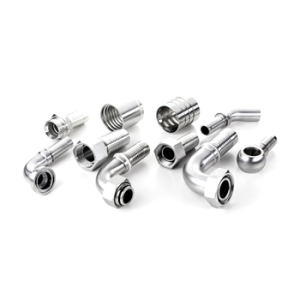Hydraulic fittings enable the connection between pipes, valves, and other components, ensuring system integrity and fluid flow safety. Choosing the appropriate hydraulic fittings is crucial for ensuring the efficiency and longevity of the hydraulic system. In this article, we will explore the main criteria for how to choose hydraulic fittings, analyzing materials, connection types, and specific applications.
Types of Hydraulic Fittings

There are various types of hydraulic fittings:
Compression Fittings
Compression fittings are widely used for their ease of installation and ability to create a leak-proof connection without the need for welding. These fittings are ideal for low and medium-pressure applications and are commonly used in domestic and industrial systems.
Threaded Fittings
Threaded fittings have male and female threads that screw together to create a solid connection. These fittings are used in applications requiring high pressure and mechanical strength. Threaded fittings are available in different thread types, such as NPT (National Pipe Thread), BSP (British Standard Pipe), and metric.
Flange Fittings
Flange fittings are designed for high-pressure connections and are used in industrial hydraulic systems. These fittings offer a robust and secure connection, facilitating maintenance and component replacement. Flanges can be welded or screwed, depending on the specific application requirements.
Materials for Hydraulic Fittings
Choosing the material for hydraulic fittings is essential to ensure chemical compatibility with the fluid used and to withstand operating conditions. The most common materials include:
Steel
Steel is one of the most used materials for hydraulic fittings due to its mechanical strength and ability to withstand high pressures. Stainless steel, in particular, is valued for its corrosion resistance, making it ideal for marine applications and harsh environments.
Brass
Brass is widely used for its excellent corrosion resistance and ease of machining. It is particularly suitable for low and medium-pressure applications, such as refrigeration systems and domestic hydraulic systems.
Plastic
Plastic fittings, such as PVC and polyethylene, are used in applications where chemical resistance and light weight are important. These fittings are ideal for low-pressure systems and are often used in agricultural and water treatment installations.
For more details on materials and their properties, you can consult authoritative resources like the Engineering Toolbox.
Considerations for Choosing Hydraulic Fittings
When selecting a hydraulic fitting, it is important to consider several key factors to ensure system compatibility and safety. These factors include:
Operating Pressure
The operating pressure of the hydraulic system is one of the main selection criteria. It is essential to choose fittings that can withstand the maximum operating pressure to avoid leaks and system failures.
Chemical Compatibility
The fitting must be compatible with the fluid used in the system to prevent corrosion and material degradation. It is important to check the technical specifications of the fitting to ensure that the material is suitable for the type of fluid.
Connection Type
The required connection type depends on the specific application and maintenance needs. For example, compression fittings are ideal for quick and temporary installations, while flange fittings are preferable for permanent and high-pressure connections.
For more details on the various types of hydraulic fittings and their applications, visit our product page.

